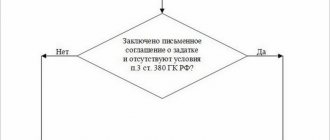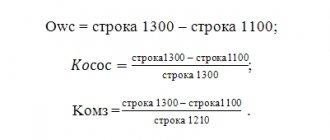What is a bill of exchange?
A bill of exchange is a security containing an obligation to pay its holder the amount specified in it. The features of how a bill of exchange is reflected in accounting are influenced by the fact that it can be:
- own or someone else's;
- simple (drawn up between 2 persons) or transferable (drawn up with the participation of a third party who will make the payment, repaying his debt to the drawer);
- discount (transferred at a price different from that indicated in it), interest (providing for the accrual of a certain percentage on the amount reflected in it) or interest-free (with a zero interest rate);
- a debt obligation, a means of payment, borrowing or investment.
It is extremely important for this document to comply with the requirements for the rules of execution and, in particular, to indicate in it (clauses 1 and 75 of the provisions “On bills of exchange and promissory notes”, approved by Resolution of the Central Executive Committee of the USSR and the Council of People's Commissars of the USSR dated 08/07/1937 No. 104/1341) :
- its name;
- dates and places of its compilation;
- offers or promises to pay a certain amount;
- the name of its payer;
- payment deadline;
- place of payment;
- to whom or on whose order the payment is made;
- signatures of the person issuing the bill.
Acceptable:
- Do not indicate payment deadline. Then the bill is paid upon presentation.
- Do not provide places of origin and payment. In this case, they will be considered the location of the payer, reflected next to his name.
- Additionally, enter information about the interest rate and the start date of its application for a bill of exchange that is interest-bearing.
- The existence of contradictions between the payment amount entered in the bill in numbers and in words. The amount indicated in words will be considered correct.
- Transfer not only a bill of exchange, but also a promissory note.
A bill of exchange can only be issued on paper (Article 4 of the Law of the Russian Federation “On Bills of Exchange and Promissory Note” dated March 11, 1997 No. 48-FZ). The fact of its transfer is reflected in the relevant agreement and act. The existence of an agreement is not necessary when issuing your own bill.
Basic Concepts
Before paying with bills, you should consider what it is, and similar data is in Article 815 of the Civil Code of the Russian Federation. According to it, the object is a security, the function of which is to fix the obligation of the issuing person to pay the monetary debt to the specified person or bearer, which is what accompanies the loan provided. Typically, a bill of exchange sets clear deadlines, and it may contain an order to a third party to pay money, but it cannot be demanded to be repaid ahead of schedule.
Types of bills
This type of securities is divided into two main types: simple and transferable; the first does not indicate who the recipient is, so such paper can be used by the bearer to reflect how much funds are to be issued. Its advantage is that you cannot limit the circle of recipients of money. To trade any bills, you can connect a specialized program, where all the necessary information will be available and a wide range of functions will be available; you can download it on the Internet.
In settlements with bills of exchange, which are called drafts, the drawer, the drawee and the remitee are involved, the first being the person who must pay for something, for example, the buyer of the goods, including the municipal unitary enterprise. The remittor is the recipient of the funds, who is indicated in the text and it is he who has the right to withdraw money under the bill.
The drawer can be a bank or a company, that is, it is an intermediary who is assigned to transfer funds to the remitter; in Russia, the task is performed by Sberbank and many other companies. In some cases, commission transactions are carried out, in particular, avalization - the execution of a bill of exchange guarantee from one of the banks to the company issuing the debt document. There is also a bill of exchange program under which such securities are formed to attract investment; all this is regulated by the Central Bank of Russia.
Bills of exchange can be either simple or transferable
Payment methods using bills of exchange
If there is a need to transfer or sell a bill of exchange, the law allows this to be done through endorsement; in most cases, an expert assessment of the paper is required. The warrant type, the holder of which is legitimized by the fact of presentation and the indication of the person in the text, can also be purchased. This is a transfer inscription that is placed on a security and indicates that the document now belongs to another person who will demand payment of funds on it.
One of the types of endorsement, forfeiting, provides for the acquisition of financial obligations of the debtor to the creditor, which is especially common in the international trading community, and the deferred export transaction turns into cash debt.
Also, an endorsement may look like an allonge - an attachment to a bill of exchange, which states the transfer of the latter. In order for the paper to enter into legal force and acquire authenticity, it is necessary to obtain acceptance, that is, written consent to fulfill obligations from one of the parties, which is actually legalization. It is indicated on the front of the paper, and if there is such an inscription, then it is possible to operate with it.
The accounting process of an accountant regarding a security and, in fact, the accounting of a bill of exchange are different concepts; the first provides for the correct reflection of the receipt and its value in the internal documentation and financial reports of the enterprise. Accounting involves the provision of funds to the creditor, that is, their return and final repayment of the bill in cash through the cash register or by bank transfer. The issuance consists of the fact that it is handed over to the first bill holder, who can further store the paper and operate with it in every possible way: receive payments of the specified amount of funds and transfer the rights of claim; the deferment can also be granted exclusively to them.
Accounting for own bills
A promissory note is usually issued by the buyer to the supplier in a situation where he cannot pay for the delivery in cash. Such a bill in the relationship between these two parties has the nature of a promissory note and is not taken into account as a security until it is transferred to a third party. Its issue and receipt is reflected by the buyer and supplier on the same settlement accounts as the principal debt. Only the analytics changes:
- from the buyer:
Dt 60calc Kt 60veks,
Where:
60calculation - subaccount for reflecting the debt for supplies,
60veks - subaccount of debt on the issued own bill;
- from the supplier:
Dt 62veks Kt 62calculation,
Where:
62veks - subaccount of debt on the buyer’s own bill of exchange received,
62calculation - subaccount for reflecting the debt for shipment.
At the same time, both parties show the appearance of such a bill on their balance sheet:
- buyer - as security issued:
Dt 009;
- supplier - as security received:
Dt 008.
If the bill is interest-bearing, then income will be accrued on it monthly, increasing the amount of the buyer’s debt on the bill:
- from the buyer:
Dt 91 Kt 60veks,
where 60veks is a subaccount of debt on the issued own bill;
- from the supplier:
Dt 62veks Kt 91,
where 62veks is a subaccount of debt on the buyer’s own bill of exchange received.
Payment on the bill will be reflected as the closure of the debt on it:
- from the buyer:
Dt 60veks Kt 51,
where 60veks is a subaccount of debt on the issued own bill;
- from the supplier:
Dt 51 Kt 62veks,
where 62veks is a subaccount of debt on the buyer’s own bill of exchange received.
At the same time, the bills will be written off from off-balance sheet accounts:
- from the buyer:
Kt 009;
- from the supplier:
Kt 008.
Read more about off-balance sheet accounts in the article “Rules for maintaining accounting records on off-balance sheet accounts.”
Accounting for other people's bills of exchange as part of financial investments
The signs of financial investments correspond to bills purchased at a price below par or interest-bearing, i.e. capable of generating income (clause 2 of PBU 19/02, approved by order of the Ministry of Finance of Russia dated December 10, 2002 No. 126n).
They are taken into account in a separate subaccount of account 58-2 (accounting chart of accounts, approved by order of the Ministry of Finance of the Russian Federation dated October 31, 2000 No. 94n) in a valuation corresponding to the amount of acquisition costs (clause 9 of PBU 19/02) or the agreed, market, estimated value ( paragraphs 12–17 PBU 19/02).
Bills of exchange can arrive in several ways, and this will determine the posting of the bill of exchange in accounting. For example:
- when purchasing this security:
Dt 58-2 Kt 76;
- payment by the buyer for delivery by third party bill:
Dt 58-2 Kt 62;
- receiving it as a contribution to the management company:
Dt 58-2 Kt 75;
- property exchange transactions:
Dt 58-2 Kt 91,
Dt 91 Kt 10 (01, 04, 41, 43, 58);
- free admission:
Dt 58-2 Kt 91.
You can see examples of how bills are reflected in accounting in various situations in ConsultantPlus:
Get trial access to K+ for free and proceed to the material.
Since each debt security is individual, bills of exchange are reflected in accounting individually and the valuation upon disposal is made at the cost of each unit. The disposal process is carried out through account 91, forming the financial result from this operation on it. In this case, the debit of account 91 includes the book value of the bill:
Dt 91 Kt 58-2.
And for the credit of account 91, the amount is formed depending on the way in which the disposal occurs. For example, via:
- redemption or sale:
Dt 76 Kt 91;
- payment by delivery bill:
Dt 60 Kt 91;
- contribution to the management company:
Dt 58-1 Kt 91;
- issuing a loan:
Dt 58-3 Kt 91;
- exchange of property:
Dt 10 (01, 04, 41, 43, 58) Kt 91.
The sale of bills of exchange is not subject to VAT (subclause 12, clause 2, article 149 of the Tax Code of the Russian Federation).
Whether it is necessary to keep separate VAT records when transactions with bills of exchange, find out from the Ready-made solution from ConsultantPlus by getting trial access to the system for free.
Income on a bill with an acquisition cost below its face value can be accounted for in one of two ways, the choice between which must be reflected in the accounting policy:
- or the book value of the bill will not change (clause 21 of PBU 19/02) and will be taken into account at the time of its disposal, reflected in the financial result;
- or the increase in the book value to the par value will be done evenly during the circulation period of the bill (clause 22 of PBU 19/02):
Dt 58-2 Kt 91.
Interest on a bill is accrued monthly, but they do not increase the accounting value of financial investments (clause 21 of PBU 19/02) and are therefore reflected in the settlement accounts:
Dt 76 Kt 91.
The amount of this interest will be included in the book value of the bill upon disposal:
Dt 91 Kt 76.
Read about the analytics of account 58 and its relationship with the data of the balance sheet lines in the article “Financial investments in the balance sheet are...”.
The bill was issued as borrowed funds
Features of the formation in accounting and financial statements of information on expenses associated with the fulfillment of obligations on loans received (including raising borrowed funds by issuing bills) and loans (including commodity and commercial) from commercial organizations are established by the norms of PBU 15/2008 “Accounting expenses on loans and credits" (Approved by Order of the Ministry of Finance of Russia dated October 6, 2008 N 107n). According to the author, the norms of this PBU can be applied when issuing a bill of exchange in cases where:
- its issuance is directly related to the receipt of a loan (the loan agreement against a bill of exchange defines the amount to be loaned and the parameters (content) of the bill of exchange issued against this amount; the act of issuing the bill of exchange contains a reference to the loan agreement);
- its issuance certifies the existence of obligations between the parties arising from the loan agreement, if the bill of exchange is transferred under a bill of exchange purchase and sale agreement for a fee (Resolution of the Presidium of the Supreme Arbitration Court of the Russian Federation dated November 24, 2009 N 9995/09);
- its issuance is a formalization of a commercial loan provided by the supplier in the form of a deferred payment for goods for the period from the date of issuance of the bill of exchange until the date of payment on it of a commercial loan (the condition for such a loan is contained in the main commercial loan agreement (Article 823 of the Civil Code of the Russian Federation, Determination of the Supreme Arbitration Court of the Russian Federation dated February 25, 2009 N 1511/09), the bill must be interest-bearing or discount to pay interest on the use of funds).
According to clause 20 of PBU 4/99 “Accounting statements of an organization” (Approved by Order of the Ministry of Finance of Russia dated July 6, 1999 N 43n), borrowed funds, which include loans and credits, are reflected, depending on the repayment period:
- or on line 1410 “Borrowed funds” as part of long-term liabilities (debt on the principal amount of debt on a loan (credit) received for a period of more than 12 months, accounted for in account 67 “Settlements on long-term loans and borrowings” until its repayment);
- or on line 1510 “Borrowed funds” as part of short-term liabilities (debt on short-term loans and credits (both interest-bearing and non-interest-bearing), reflected in account 66 “Settlements on short-term loans and borrowings”).
We conclude: if a bill of exchange is issued as borrowed funds, the obligation on it is reflected in the financial statements as part of borrowed funds.
Accounting for other people's bills that are not financial investments
Interest-free bills purchased at par or at a price above par do not meet the profitability condition established for accounting for them as financial investments (clause 2 of PBU 19/02). For this reason, they are not taken into account in account 58, but in calculations using account 76.
The ways of their receipt and disposal may be the same as for revenue bills, but in the receipt transactions, instead of account 58, account 76 will be used, and from account 76, when such bills are retired, their accounting value will be written off to the debit of account 91.
About the features of accounting for settlements with bills when applying the simplified tax system, read the material “List of expenses under the simplified tax system “income minus expenses”” .
Results
Bills of exchange in accounting have their own reflection features. These features are due both to the existence of one’s own and other people’s bills, and to the division of the latter into profitable and non-income-generating.
Sources:
- Federal Law of March 11, 1997 N 48-FZ
- Order of the Ministry of Finance of Russia dated December 10, 2002 N 126n
- Tax Code of the Russian Federation
You can find more complete information on the topic in ConsultantPlus. Free trial access to the system for 2 days.
Bill of exchange as a means of payment
If the issuance of an interest-free bill of exchange is carried out as a means of payment in payment for delivered products , as evidenced by the wording in the acts of acceptance and transfer of bills of exchange, the provisions of PBU 15/2008 do not apply to such operations, since:
- the party transferring the bill of exchange does not intend to raise borrowed funds (the bills of exchange are not issued under a loan agreement or under a bill of exchange purchase and sale agreement for a fee);
- a commercial loan is not provided (the bill is interest-free, the commercial loan clause is not included in the primary documents).
When accounting for bills of exchange issued by the buyer and transferred as payment under any agreement for goods purchased, work performed, services rendered, one should be guided by Letter of the Ministry of Finance of Russia dated October 31, 1994 N 142 “On the procedure for reflecting in accounting and reporting transactions with bills of exchange used in settlements by organizations for the supply of goods, work performed and rendered Settlements with suppliers and contractors" (or account 76 "Settlements with various debtors and creditors"), and is taken into account separately in analytical accounting for this account in the subaccount "Bills issued" until the bill is paid , that is, internal posting is made to a synthetic account 60 (or account 76).
Similar recommendations are contained in the Instructions for applying the Chart of Accounts to account 60: amounts of debt to suppliers and contractors secured by bills of exchange issued by the organization are not written off from account 60 “Settlements with suppliers and contractors”, but are taken into account separately in analytical accounting...






